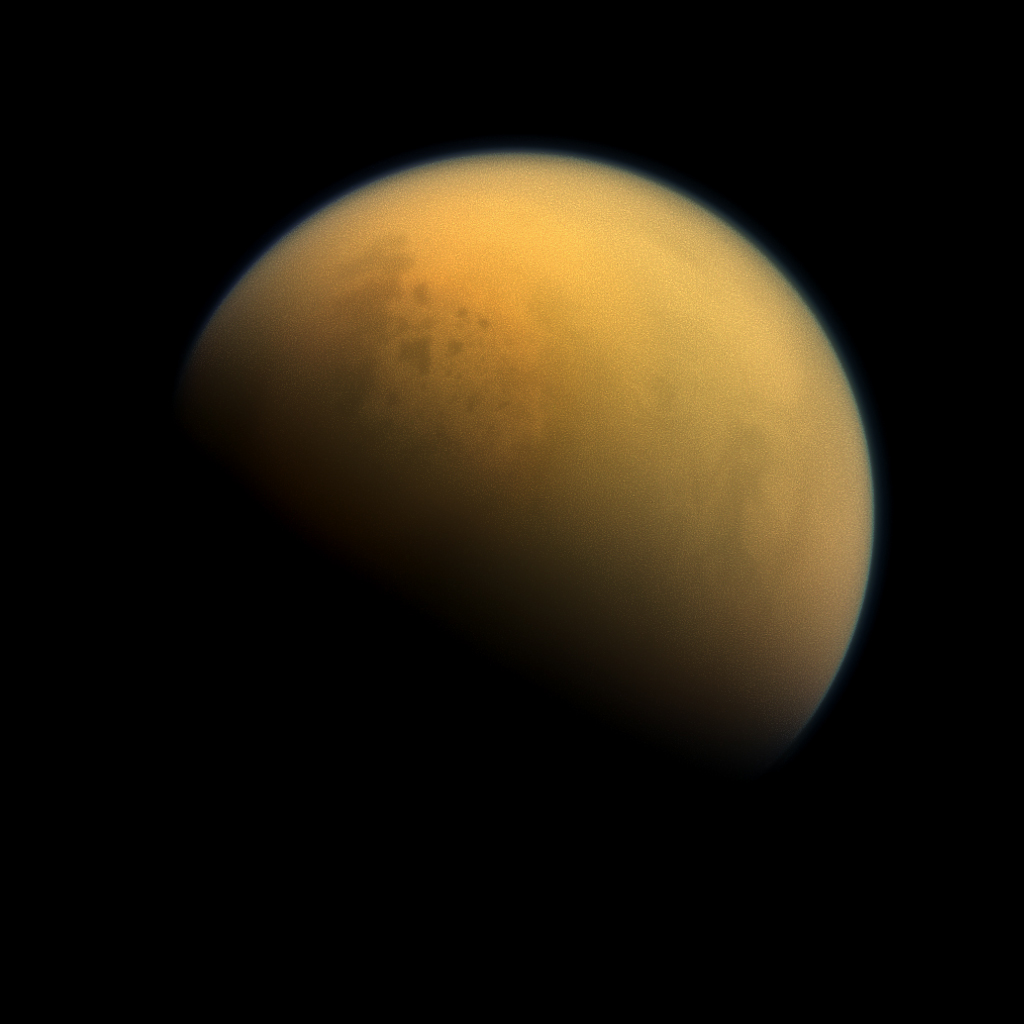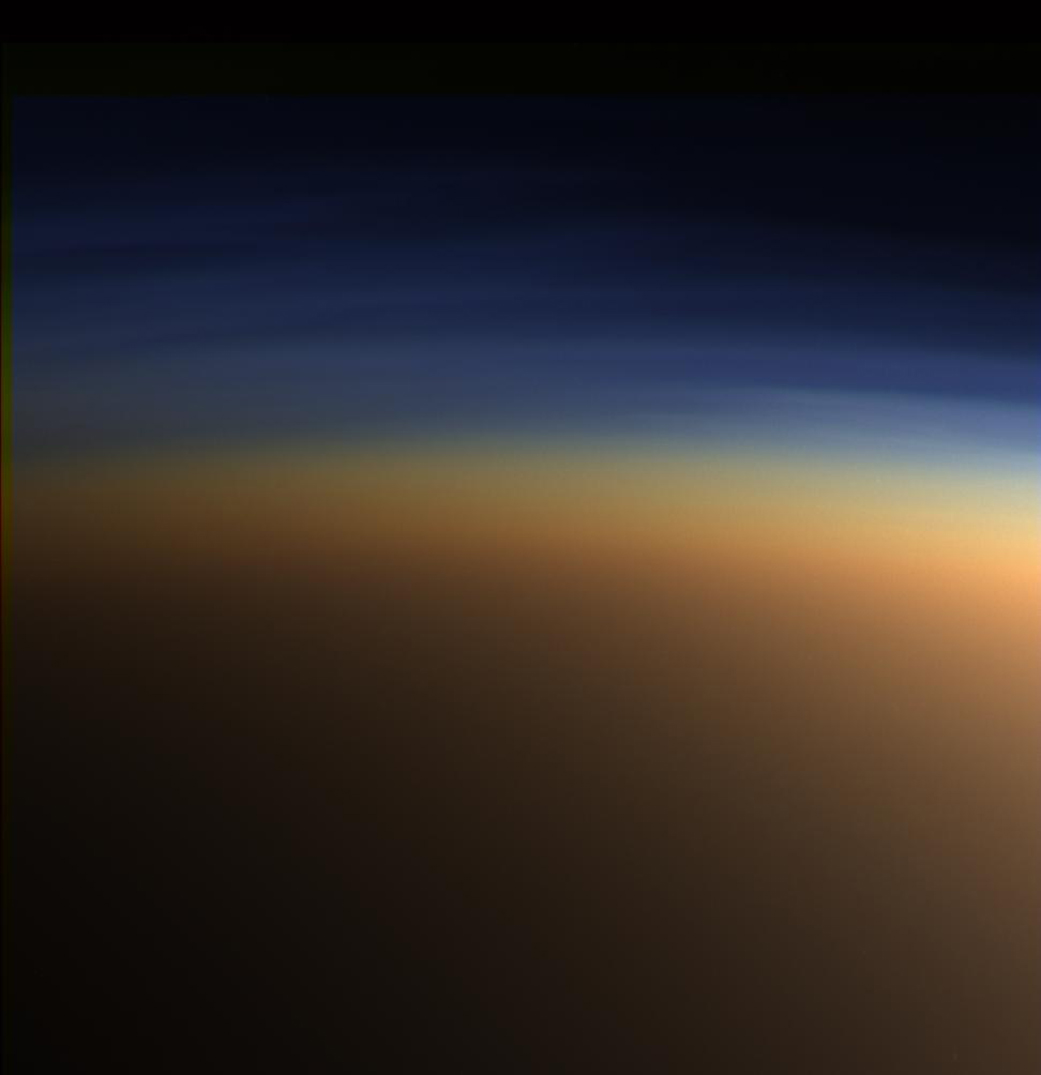Saturn's huge moon Titan harbors yet another possible key ingredient for life, a new study reports.
Titan's thick atmosphere contains large quantities of vinyl cyanide molecules, which could conceivably form membranes around cells in the liquid-hydrocarbon seas that dot the frigid moon's surface, according to the study.
Many astrobiologists regard these seas of methane as possibly habitable environments, especially considering that a variety of complex, carbon-containing organic compounds are known to exist on Titan. However, any life the moon's seas may support would have to be very different from Earth's organisms, which depend heavily on liquid water. [Amazing Photos: Titan, Saturn's Largest Moon]
Cell membranes are a case in point. Here on Earth, membranes consist of fatty molecules called lipids. But lipids cannot survive in the otherworldly Titan environment, which features a hydrocarbon-based weather system and average surface temperatures of around minus 290 degrees Fahrenheit (minus 180 degrees Celsius), study team members said.

However, computer simulations show that vinyl cyanide (C2H3CN) likely could form membranes under Titan conditions. NASA's Saturn-orbiting Cassini spacecraft has found tantalizing hints of the molecule in the moon's nitrogen-dominated atmosphere, but vinyl cyanide had never been confirmed there — until now.
In the new study, which was published online today (July 28) in the journal Science Advances, researchers detected vinyl cyanide in Titan's air after scouring data collected in 2014 by the Atacama Large Millimeter/submillimeter Array (ALMA), a network of radio telescopes in northern Chile.
And there should be a lot of the stuff: The ALMA data and computer modeling work suggest that enough vinyl cyanide has made its way down into Titan's seas to form about 10 million membranes per cubic centimeter of liquid, the researchers said. (For comparison, coastal ocean waters here on Earth harbor about 1 million bacteria per cubic cm of water.)
Get the Space.com Newsletter
Breaking space news, the latest updates on rocket launches, skywatching events and more!
That number shouldn't be taken as gospel, however.
"It's definitely a rough estimate, because there are just so many things we don't know about Titan," study lead author Maureen Palmer, of NASA's Goddard Space Flight Center in Greenbelt, Maryland, told Space.com.
While the new study helps fill in "a tiny sliver of the habitability puzzle" for Titan, it should also help scientists get a better overall handle on the chemical reactions occurring in the atmosphere of the 3,200-mile-wide (5,150 kilometers) moon, Palmer added.
"It can help lead us along to a better understanding of Titan's chemistry and what sort of increasingly complex molecules can be found there," she said.

The $3.2 billion Cassini-Huygens mission — a joint effort of NASA, the European Space Agency (ESA) and the Italian Space Agency — has been delving into that chemistry during its 13-plus years in the Saturn system. The Cassini orbiter has detected negatively charged ions, known as anions — a discovery that came as a surprise to many researchers, because anions are extremely reactive and theoretically should combine with other molecules very quickly.
In a different study, which was published Wednesday (July 26) in The Astrophysical Journal Letters, scientists identified some of these negatively charged ions as "carbon chain anions." That's a big deal, because carbon chain anions are viewed as building blocks to more complex species, and may have been involved in the reactions that led to the rise of life on Earth, members of this study team said.
"These inspiring results from Cassini show the importance of tracing the journey from small to large chemical species in order to understand how complex organic molecules are produced in an early Earth-like atmosphere," Nicolas Altobelli, ESA's Cassini-Huygens project scientist, said in a statement, referring to The Astrophysical Journal Letters paper.
"While we haven't detected life itself, finding complex organics not just at Titan but also in comets and throughout the interstellar medium [means] we are certainly coming close to finding its precursors," Altobelli added.
Follow Mike Wall on Twitter @michaeldwall and Google+. Follow us @Spacedotcom, Facebook or Google+. Originally published on Space.com.
Join our Space Forums to keep talking space on the latest missions, night sky and more! And if you have a news tip, correction or comment, let us know at: community@space.com.

Michael Wall is a Senior Space Writer with Space.com and joined the team in 2010. He primarily covers exoplanets, spaceflight and military space, but has been known to dabble in the space art beat. His book about the search for alien life, "Out There," was published on Nov. 13, 2018. Before becoming a science writer, Michael worked as a herpetologist and wildlife biologist. He has a Ph.D. in evolutionary biology from the University of Sydney, Australia, a bachelor's degree from the University of Arizona, and a graduate certificate in science writing from the University of California, Santa Cruz. To find out what his latest project is, you can follow Michael on Twitter.









